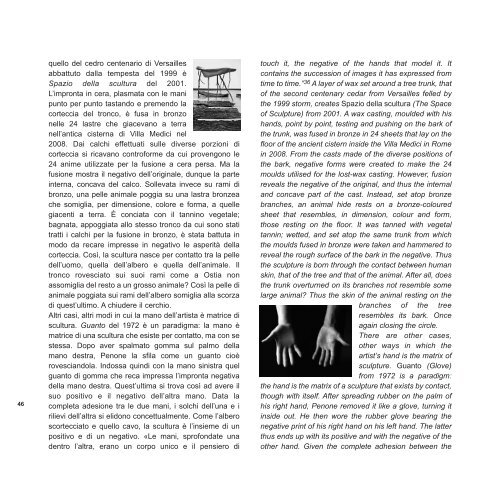Adachiara Zevi - arteinmemoria
Adachiara Zevi - arteinmemoria
Adachiara Zevi - arteinmemoria
You also want an ePaper? Increase the reach of your titles
YUMPU automatically turns print PDFs into web optimized ePapers that Google loves.
46<br />
quello del cedro centenario di Versailles<br />
abbattuto dalla tempesta del 1999 è<br />
Spazio della scultura del 2001.<br />
L’impronta in cera, plasmata con le mani<br />
punto per punto tastando e premendo la<br />
corteccia del tronco, è fusa in bronzo<br />
nelle 24 lastre che giacevano a terra<br />
nell’antica cisterna di Villa Medici nel<br />
2008. Dai calchi effettuati sulle diverse porzioni di<br />
corteccia si ricavano controforme da cui provengono le<br />
24 anime utilizzate per la fusione a cera persa. Ma la<br />
fusione mostra il negativo dell’originale, dunque la parte<br />
interna, concava del calco. Sollevata invece su rami di<br />
bronzo, una pelle animale poggia su una lastra bronzea<br />
che somiglia, per dimensione, colore e forma, a quelle<br />
giacenti a terra. È conciata con il tannino vegetale;<br />
bagnata, appoggiata allo stesso tronco da cui sono stati<br />
tratti i calchi per la fusione in bronzo, è stata battuta in<br />
modo da recare impresse in negativo le asperità della<br />
corteccia. Così, la scultura nasce per contatto tra la pelle<br />
dell’uomo, quella dell’albero e quella dell’animale. Il<br />
tronco rovesciato sui suoi rami come a Ostia non<br />
assomiglia del resto a un grosso animale? Così la pelle di<br />
animale poggiata sui rami dell’albero somiglia alla scorza<br />
di quest’ultimo. A chiudere il cerchio.<br />
Altri casi, altri modi in cui la mano dell’artista è matrice di<br />
scultura. Guanto del 1972 è un paradigma: la mano è<br />
matrice di una scultura che esiste per contatto, ma con se<br />
stessa. Dopo aver spalmato gomma sul palmo della<br />
mano destra, Penone la sfila come un guanto cioè<br />
rovesciandola. Indossa quindi con la mano sinistra quel<br />
guanto di gomma che reca impressa l’impronta negativa<br />
della mano destra. Quest’ultima si trova così ad avere il<br />
suo positivo e il negativo dell’altra mano. Data la<br />
completa adesione tra le due mani, i solchi dell’una e i<br />
rilievi dell’altra si elidono concettualmente. Come l’albero<br />
scortecciato e quello cavo, la scultura è l’insieme di un<br />
positivo e di un negativo. «Le mani, sprofondate una<br />
dentro l’altra, erano un corpo unico e il pensiero di<br />
touch it, the negative of the hands that model it. It<br />
contains the succession of images it has expressed from<br />
time to time.” 36 A layer of wax set around a tree trunk, that<br />
of the second centenary cedar from Versailles felled by<br />
the 1999 storm, creates Spazio della scultura (The Space<br />
of Sculpture) from 2001. A wax casting, moulded with his<br />
hands, point by point, testing and pushing on the bark of<br />
the trunk, was fused in bronze in 24 sheets that lay on the<br />
floor of the ancient cistern inside the Villa Medici in Rome<br />
in 2008. From the casts made of the diverse positions of<br />
the bark, negative forms were created to make the 24<br />
moulds utilised for the lost-wax casting. However, fusion<br />
reveals the negative of the original, and thus the internal<br />
and concave part of the cast. Instead, set atop bronze<br />
branches, an animal hide rests on a bronze-coloured<br />
sheet that resembles, in dimension, colour and form,<br />
those resting on the floor. It was tanned with vegetal<br />
tannin; wetted, and set atop the same trunk from which<br />
the moulds fused in bronze were taken and hammered to<br />
reveal the rough surface of the bark in the negative. Thus<br />
the sculpture is born through the contact between human<br />
skin, that of the tree and that of the animal. After all, does<br />
the trunk overturned on its branches not resemble some<br />
large animal? Thus the skin of the animal resting on the<br />
branches of the tree<br />
resembles its bark. Once<br />
again closing the circle.<br />
There are other cases,<br />
other ways in which the<br />
artist’s hand is the matrix of<br />
sculpture. Guanto (Glove)<br />
from 1972 is a paradigm:<br />
the hand is the matrix of a sculpture that exists by contact,<br />
though with itself. After spreading rubber on the palm of<br />
his right hand, Penone removed it like a glove, turning it<br />
inside out. He then wore the rubber glove bearing the<br />
negative print of his right hand on his left hand. The latter<br />
thus ends up with its positive and with the negative of the<br />
other hand. Given the complete adhesion between the


